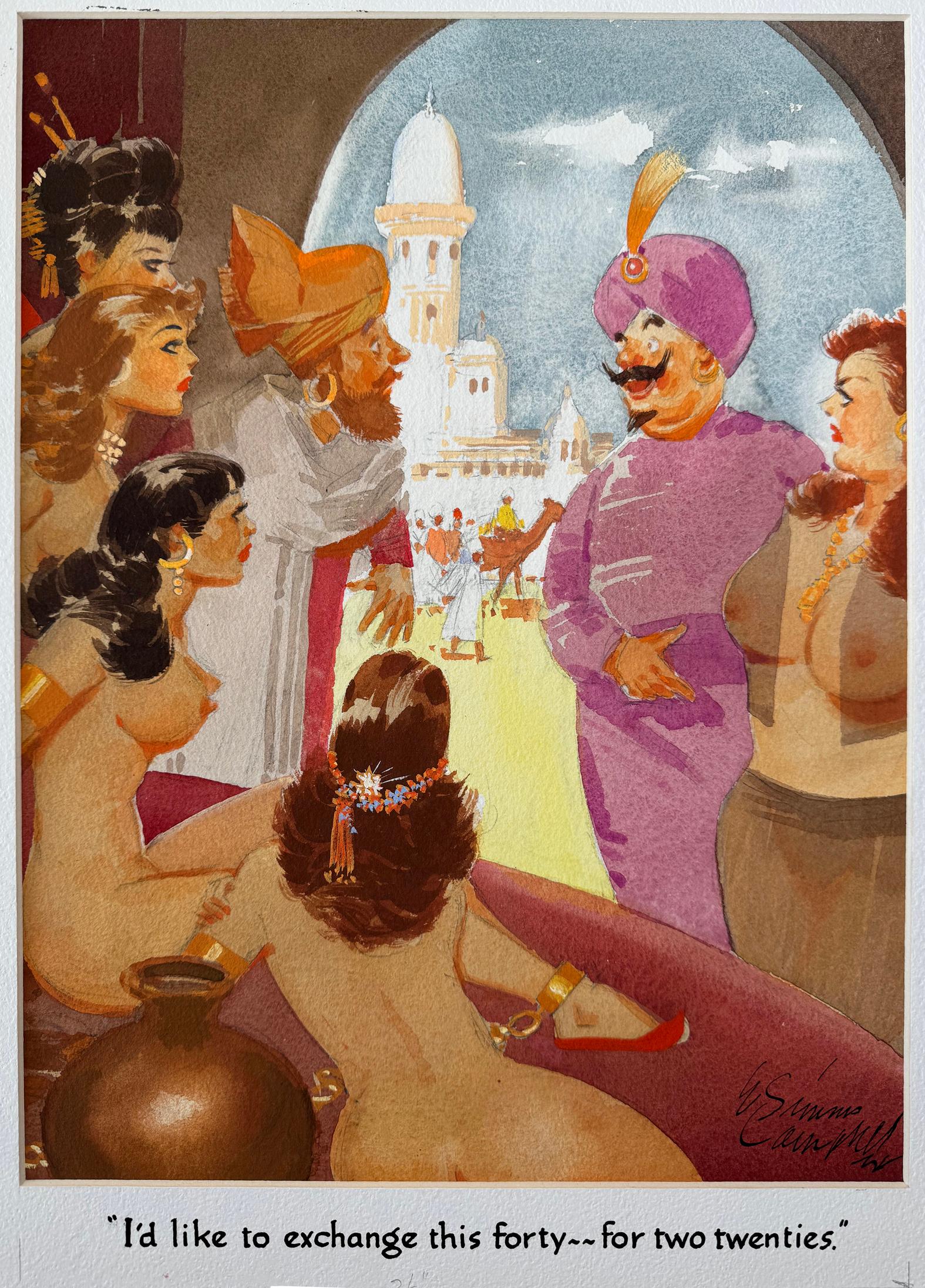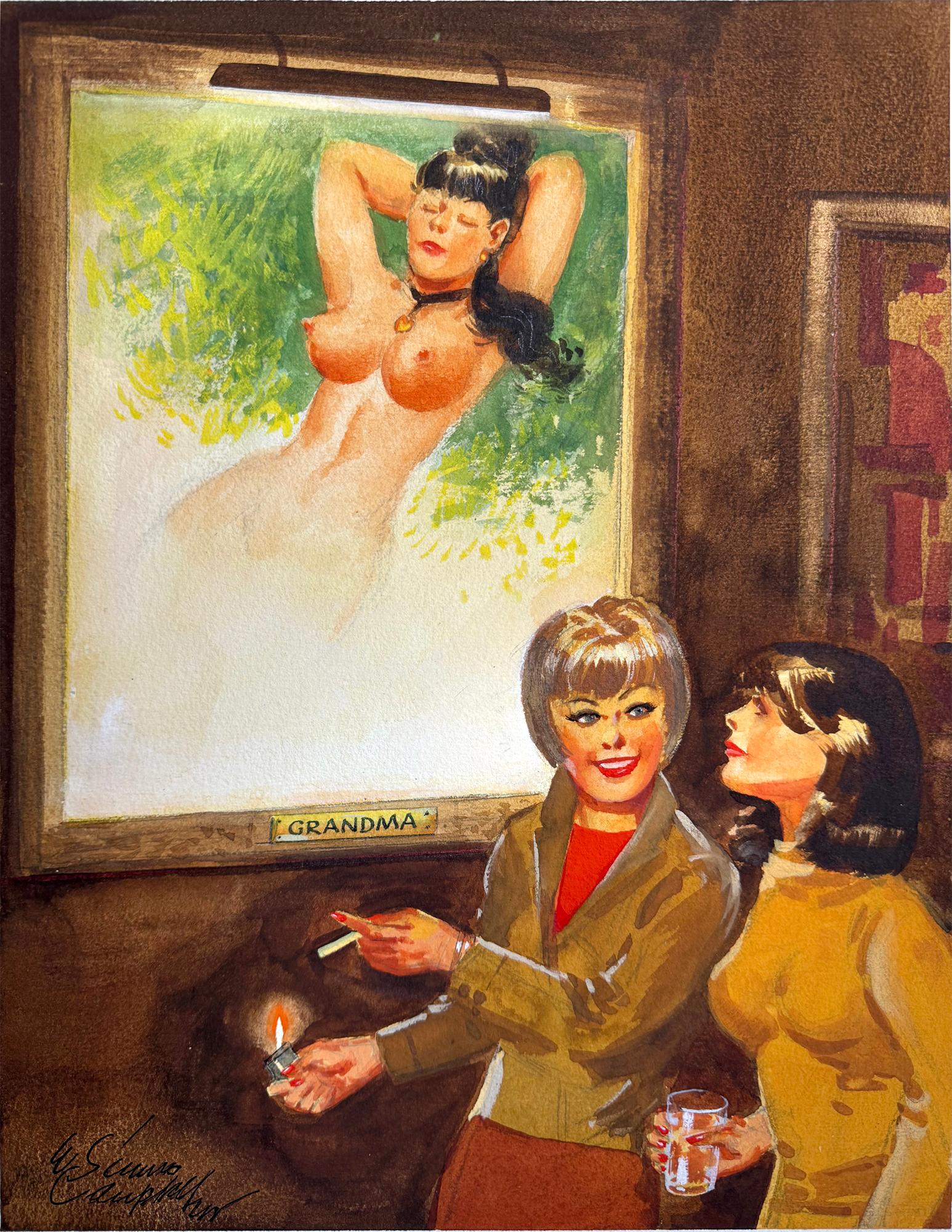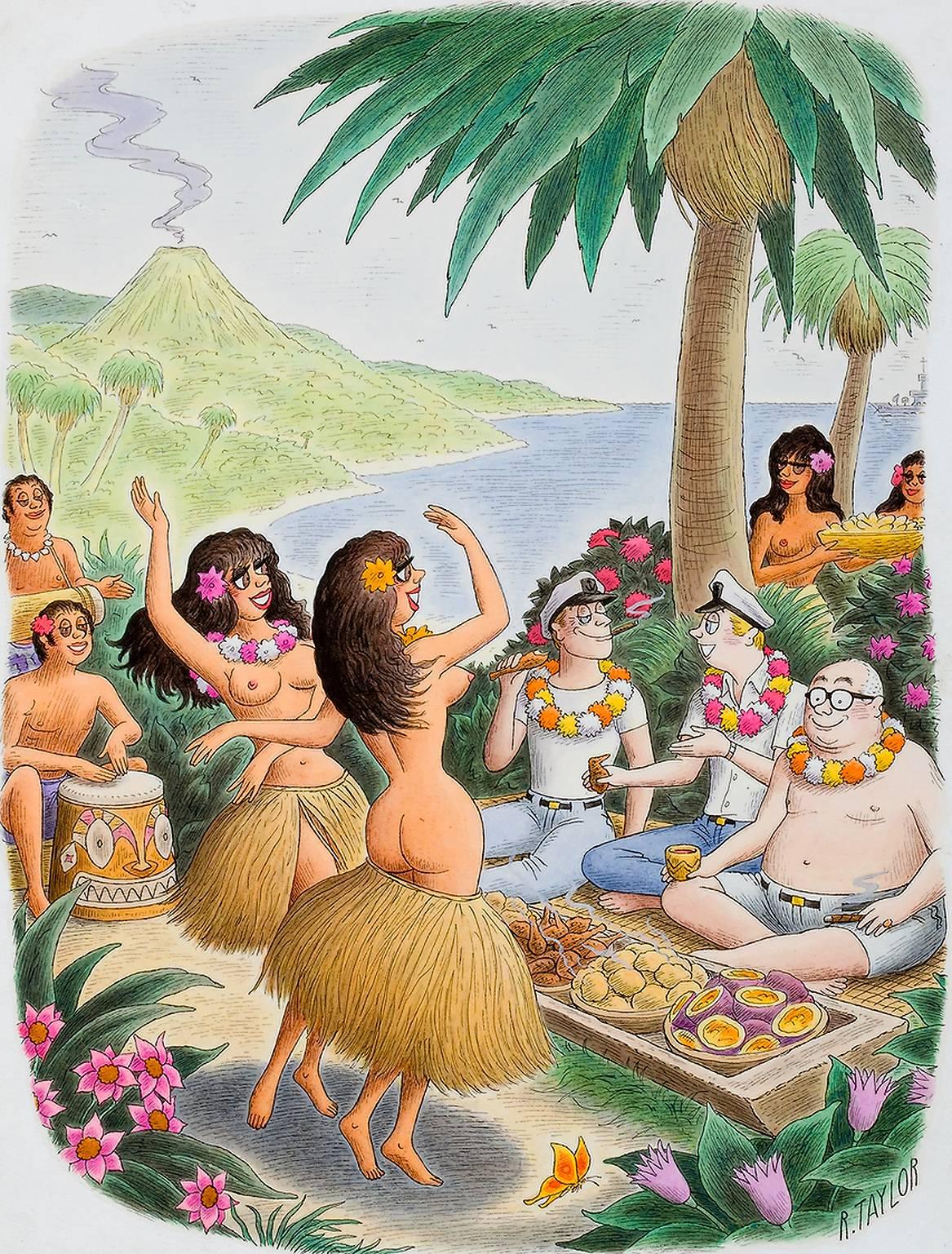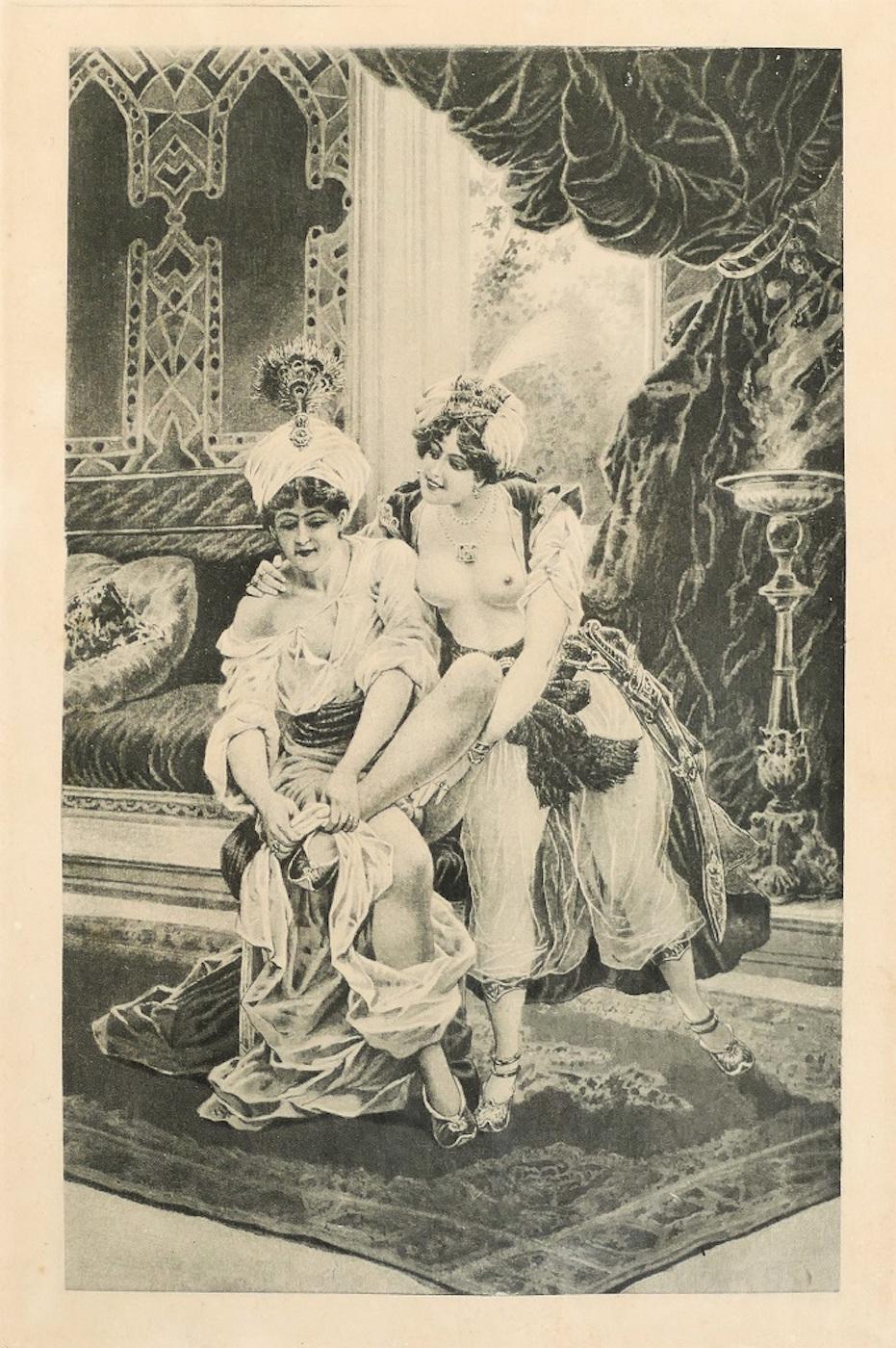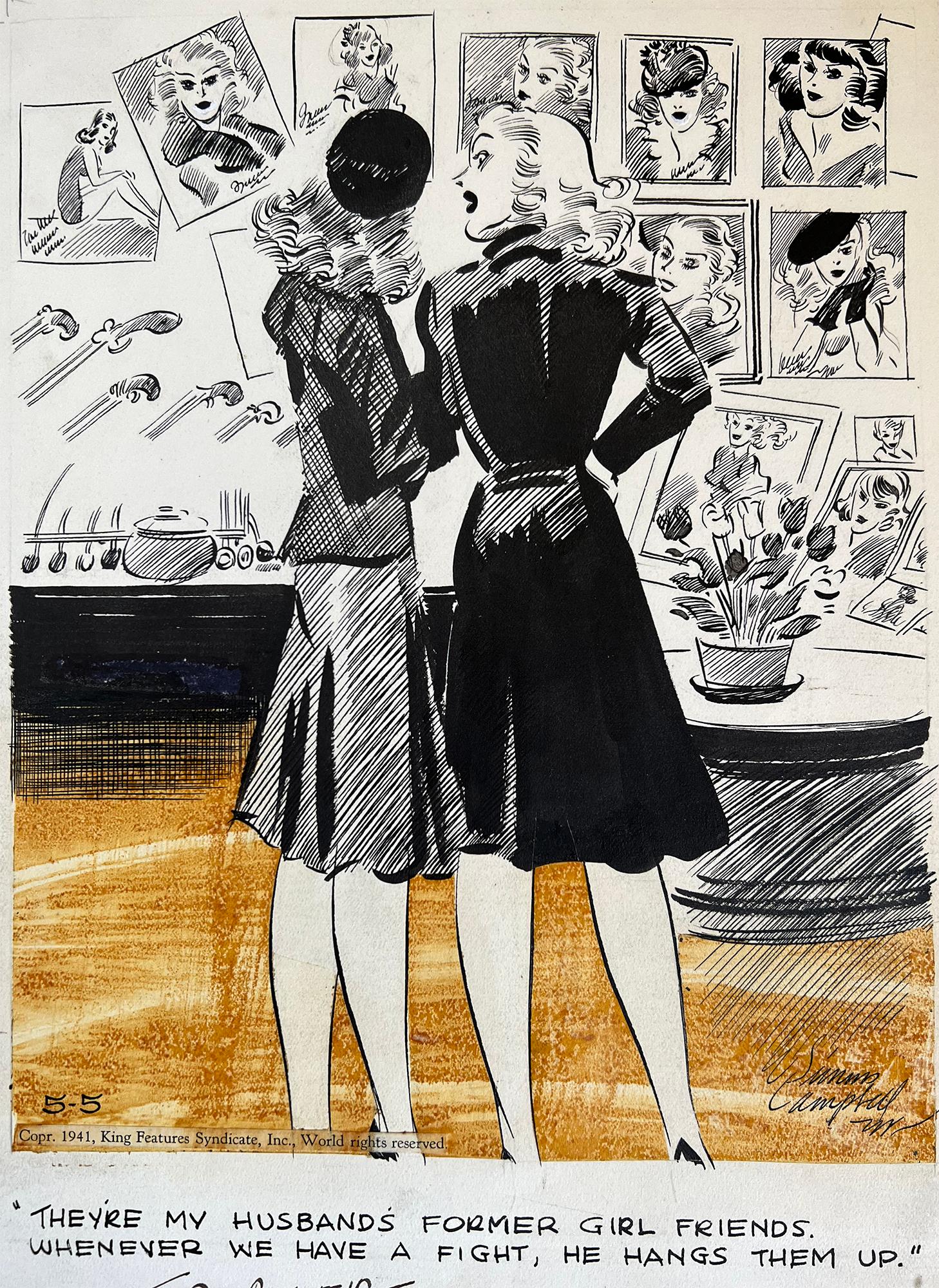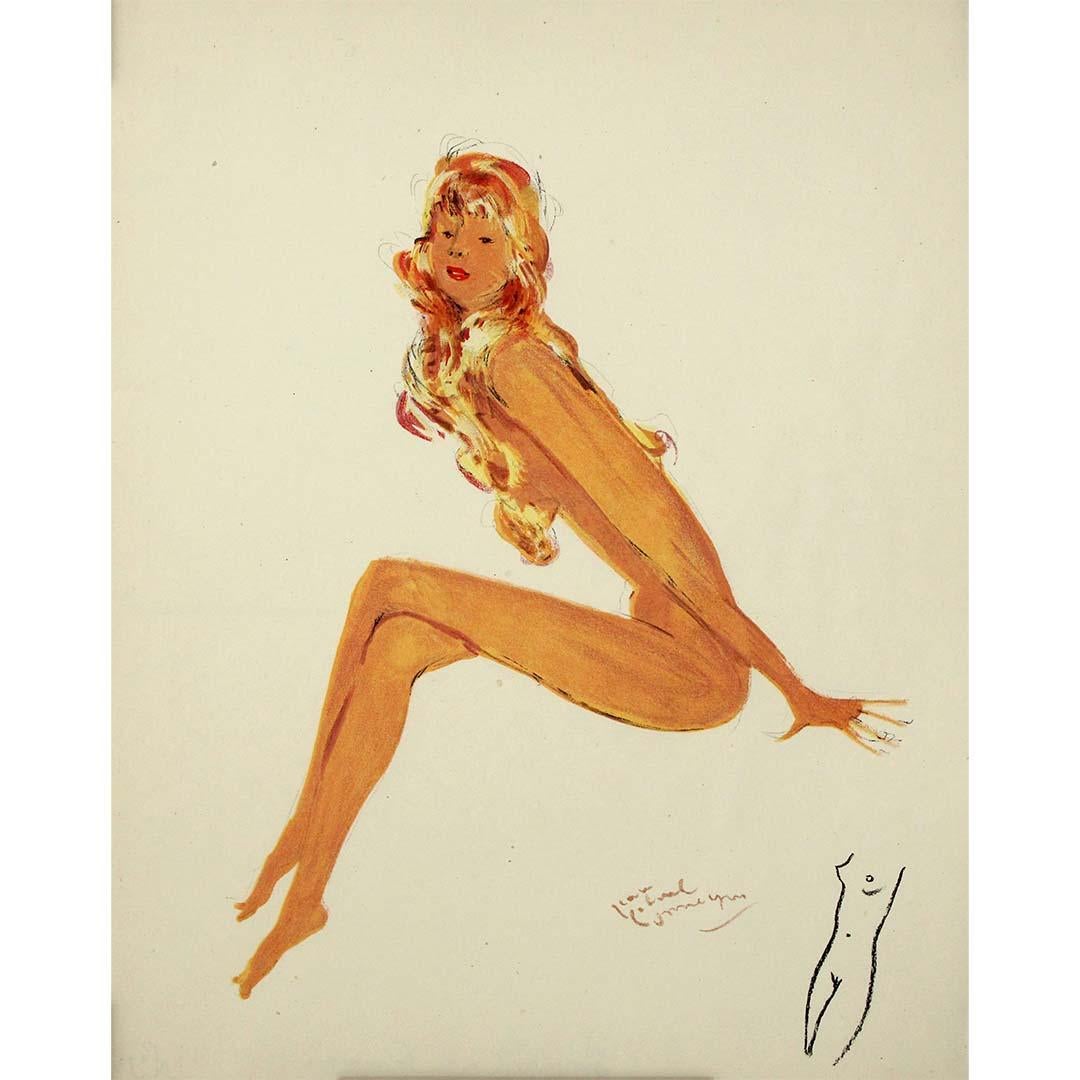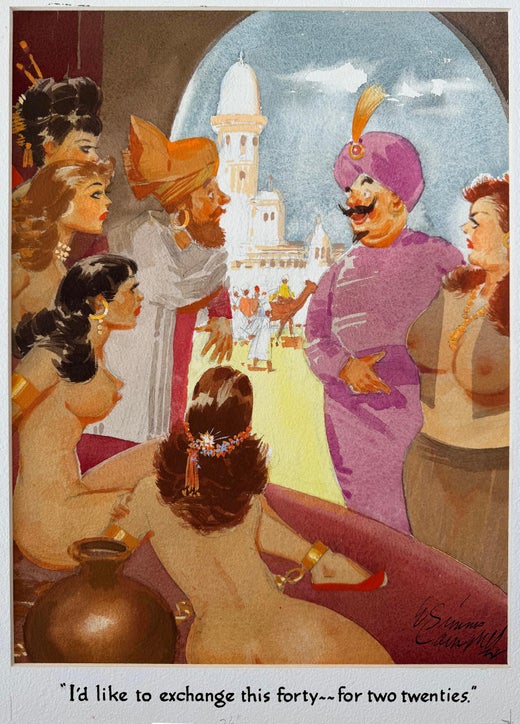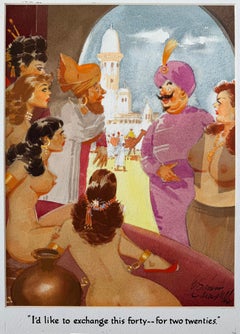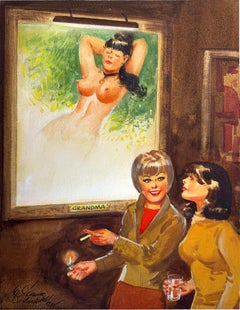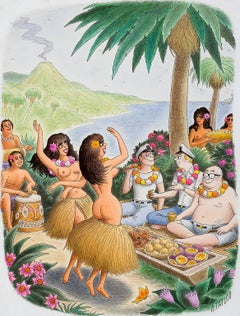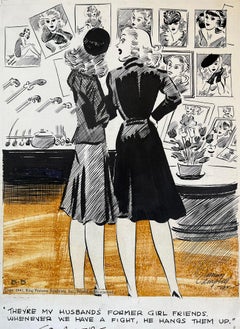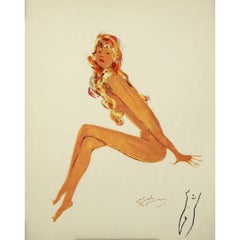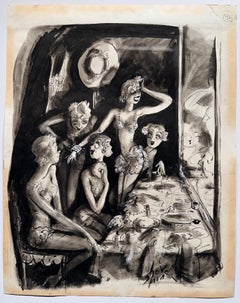Items Similar to Beautiful Maidens Nude Women Harem, Playboy Cartoon African American Illustrator
Want more images or videos?
Request additional images or videos from the seller
1 of 13
E. Simms CampbellBeautiful Maidens Nude Women Harem, Playboy Cartoon African American Illustrator1962
1962
$25,000
£19,113.83
€22,015.27
CA$35,032.67
A$39,110.68
CHF 20,493.41
MX$478,753.07
NOK 260,266.46
SEK 245,398.23
DKK 164,302.24
Shipping
Retrieving quote...The 1stDibs Promise:
Authenticity Guarantee,
Money-Back Guarantee,
24-Hour Cancellation
About the Item
E. Simms Campbel was the first major African American Illustrator. He did covers for Esquire Magazine starting in the 1930s.
He created the famous bulging-eyed Esquire Mascot “Esky.”
He also worked for The Chicagoan, Cosmopolitan, Ebony, The New Yorker, Playboy, Opportunity: A Journal of Negro Life, Pictorial Review, and Redbook.
This work, "What do you mean your wife doesn't understand you ---- I'm your wife!" is from Cuties Daily Comic Strip, June 18, 1950
He was inducted into the Society of Illustrators' Hall of Fame in 2002.
His work demonstrates a deep and masterfully understanding of drawing figures and faces in an academic but stylized style.
"My pleasure, boys. Always glad to see a delegation from the States." From the Playboy Collection
Signed upper left.
The art board has an overall size of 16.75 x 12.5
Work is smartly framed
- Creator:E. Simms Campbell (1906 - 1971, American)
- Creation Year:1962
- Dimensions:Height: 13.5 in (34.29 cm)Width: 10.5 in (26.67 cm)
- Medium:
- Movement & Style:
- Period:
- Condition:
- Gallery Location:Miami, FL
- Reference Number:1stDibs: LU385310822162
E. Simms Campbell
Elmer Simms Campbell (January 2, 1906 – January 27, 1971) was an American commercial artist best known as the cartoonist who signed his work, E. Simms Campbell. The first African-American cartoonist published in nationally distributed, slick magazines, he created Esky,the familiar pop-eyed mascot of Esquire. Campbell was born in St. Louis, Missouri, the son of educators, Elizabeth Simms Campbell & Elmer Campbell
He then enrolled in the University of Chicago. After one year, Campbell left the University of Chicago and transferred to and received his degree from the Chicago Art Institute.
He spent two years at Triad Studios before moving to New York City in 1929. taking classes at the National Academy of Design. During this time, he contributed to various magazines, notably Life, & Judge.
Following the suggestion of cartoonist Russell Patterson to focus on good girl art, Campbell created his "Harem Girls", a series of watercolor cartoons that attracted attention in the first issue of Esquire, debuting in 1933. Campbell's artwork was in almost every issue of Esquire from 1933 to 1958 & he was the creator of its continuing mascot, the cartoon character in a silk top hat.
He also contributed to The Chicagoan, Cosmopolitan, Ebony, The New Yorker, Playboy, Opportunity: A Journal of Negro Life, Pictorial Review, and Redbook.
His commercial artwork for advertising included illustrations for Barbasol, Springmaid,Hart Schaffner & Marx.
Campbell also was the author of a chapter on blues music in the 1939 book Jazzmen, a seminal study of jazz's history and development.
Campbell died in White Plains, New York, in 1971
His gag panel, Cuties, was syndicated by King Features in more than 145 newspapers "A Night-Club Map of 1930s Harlem"
Of enduring cultural & historical interest is the witty, cartoon-filled map Campbell drew in 1932 – "A Night-Club Map of 1930s Harlem" identifying the attractions of Harlem during the Harlem Renaissance and adding his personal notes. He captures the intensity of the scene: within a few blocks of each other he has cartooned Cab Calloway singing at the Cotton Club, Bill "Bojangles" Robinson doing his step dance at the Lafayette Theater – "Friday night is the Midnight show, Most Negro revues begin and end here." Lissome "cafe au lait girls" dance at Small's Paradise. Outside, doormen welcome White swells in top hats, while an elegant Black couple in evening dress dance "the Bump"
Campbell's map appears in the book version of Ken Burns's documentary Jazz. The map in its entirety also appears as the inside front cover of "Of Minnie the Moocher and Me", the autobiography of Cab Calloway by Cab Calloway and Bryant Rollins (TY Crowell, 1976). Jazz historian Mike Thibault reports that the original was displayed by the Smithsonian in 1996.The map is currently held at the Yale Beinecke Rare Book & Manuscript Library.
On April 4, 2017, National Geographic published an article on the map that included the map and several enlarged sections of it. They featured it again during 2020 to subscribers of their newsletter, among a collection of unique maps of New York City.
Recognition
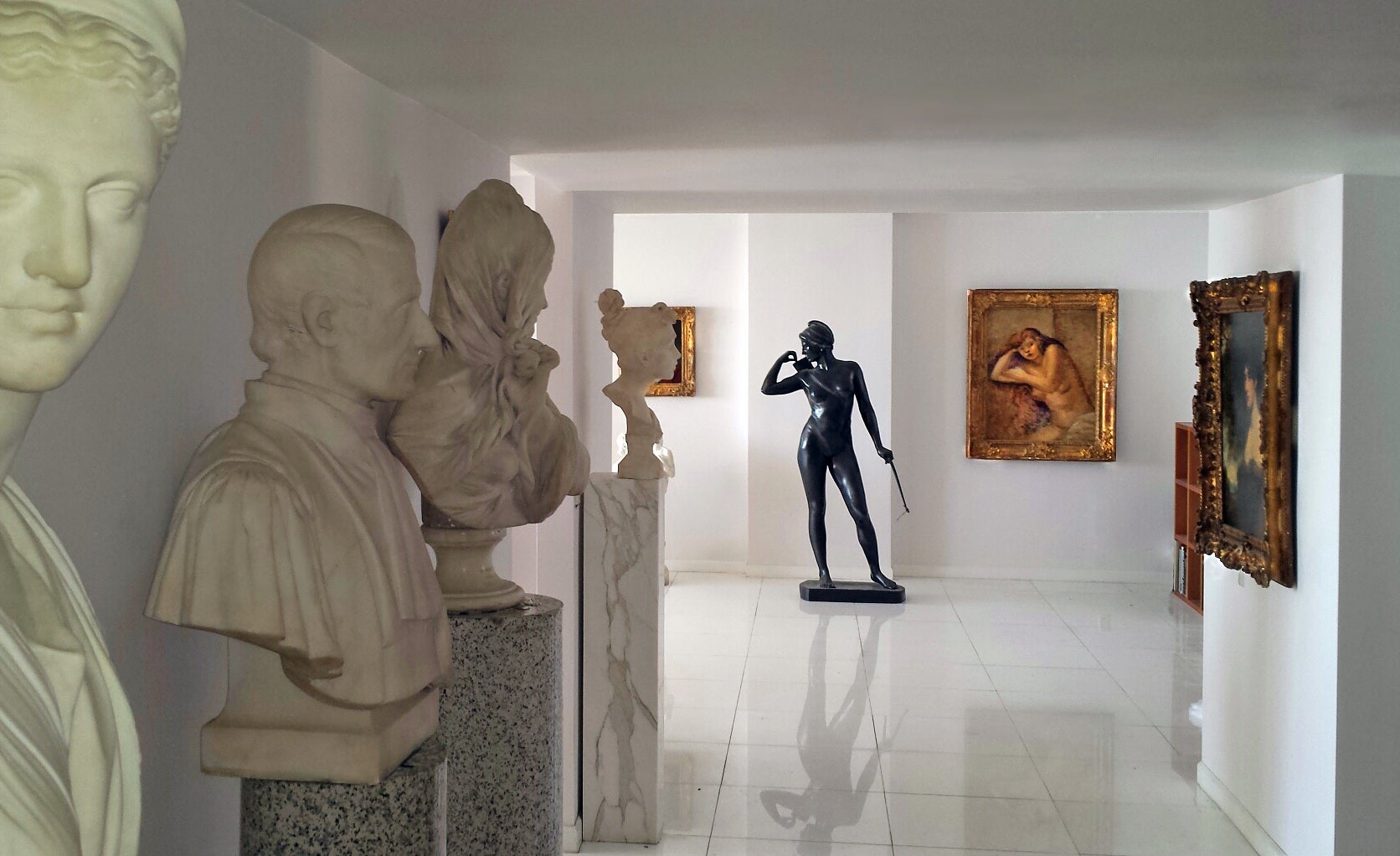
About the Seller
4.9
Gold Seller
Premium sellers maintaining a 4.3+ rating and 24-hour response times
Established in 2005
1stDibs seller since 2016
115 sales on 1stDibs
Typical response time: 1 hour
- ShippingRetrieving quote...Shipping from: Miami, FL
- Return Policy
Authenticity Guarantee
In the unlikely event there’s an issue with an item’s authenticity, contact us within 1 year for a full refund. DetailsMoney-Back Guarantee
If your item is not as described, is damaged in transit, or does not arrive, contact us within 7 days for a full refund. Details24-Hour Cancellation
You have a 24-hour grace period in which to reconsider your purchase, with no questions asked.Vetted Professional Sellers
Our world-class sellers must adhere to strict standards for service and quality, maintaining the integrity of our listings.Price-Match Guarantee
If you find that a seller listed the same item for a lower price elsewhere, we’ll match it.Trusted Global Delivery
Our best-in-class carrier network provides specialized shipping options worldwide, including custom delivery.More From This Seller
View AllHarem: Sexy Nude Girl Illustration for Playboy. First Black Illustrator
By E. Simms Campbell
Located in Miami, FL
Playboy Magazine ran this joke cartoon illustration in color on page 43 for the October 1960 edition.
Signed lower right.
The work is executed on a heavy Whatman Illustration board....
Category
1960s American Modern Nude Drawings and Watercolors
Materials
Watercolor, Illustration Board, Pencil, Gouache
Nude Playboy Cartoon, First African American Illustrator Elmer Simms Campbell
By E. Simms Campbell
Located in Miami, FL
E. Simms Campbell was the first and top black commercial artist in the USA for decades.
In "Grandma," we see a deeply conceptual work, with the blank canvas as the main point of the...
Category
1960s Impressionist Nude Paintings
Materials
Watercolor, Illustration Board, Pencil
Nude Girls Dance Playboy cartoon "They Say Every Little Gesture Has Meaning
By Richard Taylor
Located in Miami, FL
"They Say Every Little Gesture Has a Meaning", Playboy cartoon illustration, August 1968
Pen and watercolor on board
12.5 x 9.5 in. (image)
Signed...
Category
1960s American Realist Nude Paintings
Materials
Watercolor, Pen
My Husbands Former Girl Friends - First Black Illustrator/ Black Cartoonist
By E. Simms Campbell
Located in Miami, FL
Cuties Cartoon Strip - E. Simms Campbell
My Husband Former Girl Friends - First Black Illustrator/ Cartoonist,
Category
1940s Contemporary Portrait Drawings and Watercolors
Materials
Ink, Board
Santa Claus Sexy Playboy Cartoon First African American Illustrator, Elmer Simms
By E. Simms Campbell
Located in Miami, FL
Santa has a quickie with Mom.
Elmer Simms Campbell was the first African American Illustrator to work for major newsstand magazines.
Published December, 1963
Signed in pencil lower...
Category
1960s Realist Figurative Paintings
Materials
Watercolor, Illustration Board, Pencil
Art Deco Pulp cover or pin-up magazine cover
By Peter Driben
Located in Miami, FL
Pulp cover or pin-up magazine cover
signed lower left
foxing and toning throughout
oil and mixed media on board
work is framed
Category
1920s Art Deco Figurative Paintings
Materials
Oil, Mixed Media, Board
You May Also Like
The Harem - Heliogravure - 1906
Located in Roma, IT
Image dimensions: 17.7 x 13.5 cm.
The Harem is a black and white héliogravure on paper, realized in 1906 by an anonymous Austrian artist.
An original illu...
Category
Early 1900s Symbolist Figurative Prints
Materials
Engraving
1956 lithography by Jean-Gabriel Domergue - Sylvie la manucure
By Jean-Gabriel Domergue
Located in PARIS, FR
The 1956 lithography by Jean-Gabriel Domergue Sylvie la manucure, part of the renowned La Parisienne portfolio, stands as an elegant representation of post-war French art and a celeb...
Category
1950s Prints and Multiples
Materials
Lithograph, Paper
Orientalism : Young Women Playing - Original Lithograph, 1898
By Paul Leroy
Located in Paris, IDF
Paul LEROY
Orientalism : Young Women Playing, 1898
Original lithograph (Champenois workshop)
Printed signature in the plate
On vellum, 40 x 31 cm (c. 16 x 12 in)
INFORMATION: Litho...
Category
1890s Art Nouveau Figurative Prints
Materials
Lithograph
Life Magazine Art Deco Showgirls Cartoon
Located in Wilton Manors, FL
Barbara Shermund (1899-1978). Showgirls Cartoon for Life Magazine, 1934. Ink, watercolor and gouache on heavy illustration paper, matting window measures 16.5 x 13 inches; sheet measures 19 x 15 inches; Matting panel measures 20 x 23 inches. Signed lower right. Very good condition with discoloration and toning in margins. Unframed.
Provenance: Ethel Maud Mott Herman, artist (1883-1984), West Orange NJ.
For two decades, she drew almost 600 cartoons for The New Yorker with female characters that commented on life with wit, intelligence and irony.
In the mid-1920s, Harold Ross, the founder of a new magazine called The New Yorker, was looking for cartoonists who could create sardonic, highbrow illustrations accompanied by witty captions that would function as social critiques.
He found that talent in Barbara Shermund.
For about two decades, until the 1940s, Shermund helped Ross and his first art editor, Rea Irvin, realize their vision by contributing almost 600 cartoons and sassy captions with a fresh, feminist voice.
Her cartoons commented on life with wit, intelligence and irony, using female characters who critiqued the patriarchy and celebrated speakeasies, cafes, spunky women and leisure. They spoke directly to flapper women of the era who defied convention with a new sense of political, social and economic independence.
“Shermund’s women spoke their minds about sex, marriage and society; smoked cigarettes and drank; and poked fun at everything in an era when it was not common to see young women doing so,” Caitlin A. McGurk wrote in 2020 for the Art Students League.
In one Shermund cartoon, published in The New Yorker in 1928, two forlorn women sit and chat on couches. “Yeah,” one says, “I guess the best thing to do is to just get married and forget about love.”
“While for many, the idea of a New Yorker cartoon conjures a highbrow, dry non sequitur — often more alienating than familiar — Shermund’s cartoons are the antithesis,” wrote McGurk, who is an associate curator and assistant professor at Ohio State University’s Billy Ireland Cartoon Library & Museum. “They are about human nature, relationships, youth and age.” (McGurk is writing a book about Shermund.
And yet by the 1940s and ’50s, as America’s postwar focus shifted to domestic life, Shermund’s feminist voice and cool critique of society fell out of vogue. Her last cartoon appeared in The New Yorker in 1944, and much of her life and career after that remains unclear. No major newspaper wrote about her death in 1978 — The New York Times was on strike then, along with The Daily News and The New York Post — and her ashes sat in a New Jersey funeral home...
Category
1930s Art Deco Figurative Paintings
Materials
Ink, Gouache
$3,250 Sale Price
35% Off
"Two Female Nudes, " Mid-Century, Finely Detailed Masterpiece, Alexander Cañedo
By Alexandro De Canedo
Located in Philadelphia, PA
Author of "How Cañedo Draws the Figure" and one of the acknowledged masters of the nude in the Art Deco and Mid-Century periods, Alexander Cañedo painted this remarkable scene of two female...
Category
Vintage 1940s American Art Deco Paintings
Materials
Paint
$6,000 Sale Price
20% Off
1956 lithography by Jean-Gabriel Domergue - Elvire qui sait tout - La Parisienne
By Jean-Gabriel Domergue
Located in PARIS, FR
The 1956 lithography by Jean-Gabriel Domergue from the renowned portfolio La Parisienne is a striking example of mid-20th-century French art, showcasing the elegance and allure of th...
Category
1950s Prints and Multiples
Materials
Lithograph, Paper
